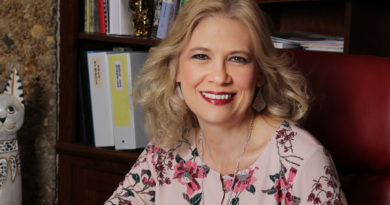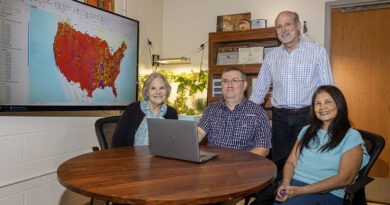Baylor Scott & White Medical Center–Temple: Making great strides in community healthcare
By Stacy Moser
Photograph courtesy of Baylor Scott & White Health
Baylor Scott & White Medical Center–Temple is considered by many to be the proverbial rolling stone. It’s not gathering any moss when it comes to bringing technological advancements to its patients.
The hospital has become a destination for physicians from around the world who seek models of the latest innovations in a hospital setting. Dr. Kirby Hitt, the medical center’s director of joint replacement, was recently invited to speak at a meeting in Japan related to joint-replacement techniques and implant designs. As a result of that meeting, several doctors traveled to Temple from Japan to collaborate with the hospital’s joint-replacement program.
“It was an honor to have many of the most influential joint surgeons from Japan spend time observing various replacement cases, sharing an international perspective on healthcare reform and discussing techniques to improve knee- and hip-replacement surgery for our patients,” says Hitt. “This collaboration has resulted in monthly symposiums in order to continue the education process and create opportunities to work together on research projects.”
While the hospital wraps up its construction of a new surgical sciences facility, adding 11 large, high-tech operating rooms, advances are occurring within the hospital’s walls, too.
For example, the structural heart failure clinic continues to address a common medical condition, aortic stenosis of the heart (narrowing of the main valve), which affects nearly 1.5 million people in the United States. The condition impedes blood flow from the heart and, traditionally, open-heart surgery was the best remedy. Now, though, surgeons at Baylor Scott & White are performing transcatheter aortic valve replacements (TAVR), an exciting new alternative treatment. TAVR sends a catheter to repair the heart’s valve through a small needle puncture, usually in a blood vessel in the leg. The big plus with this type of surgery is the reduced down time for patients as they recover—and a faster return home.
Surgeons at Baylor Scott & White in Temple were instrumental to the success of the clinical trials for this new surgery and recently performed their 500th TAVR procedure. “TAVR made it possible for even the frailest of patients to improve their overall heart function,” explains Mark Lawrence, MD, an interventional cardiologist. “We’ve given our patients an opportunity to recover faster and with less risk.”
Another innovative procedure pioneered at the medical center, holmium laser enucleation of the prostate (HoLEP), provides much-needed relief for men with benign prostatic hyperplasia (BPH), a condition that can prevent the bladder from emptying properly and, in severe cases, can cause urinary retention, leading to catheter dependence.
Dr. Marawan El Tayeb, a urologist at the medical center, averages almost 200 HoLEP procedures a year, the highest number in Texas. “It’s a very good feeling to provide this procedure to patients who otherwise don’t have a lot of options available,” he says.
“This procedure has had a tremendous impact for men,” reports Dr. Erin Bird, director of urology at Baylor Scott & White. “Many patients with especially large prostates had catheters for years because they believed nothing else could be done. Our medical team of doctors, nurses, clinicians and staff work together to ensure these patients recover and enjoy activities they may not have been able to do previously.”
One other example of life-saving surgery at the hospital is the kidney-transplantation program in which a record 153 abdominal organ transplants were performed in one year, surpassing the previous record of 87. “This accomplishment is a result of our team’s commitment to providing exemplary care for patients in need of a kidney transplant,” says Abbie Dawson, BSN, RN, nurse supervisor of the transplant program. “Every member of the transplant team has a significant role and, through diligent work and dedication, we continue to provide quality and compassionate care for patients in need of a life-saving organ.”
The transplant team now offers many options to patients in need of an organ, including a living-donor program, paired kidney donor program and a relatively new patient program, Training for Transplant. This program gives potential transplant patients a way to improve their risk factors through careful planning and care coordination. The program also has affected the methodology for kidney evaluation, allowing for the acceptance of more kidneys for transplantation at the hospital. “This is just another example of our multi-disciplinary approach to care,” says Erin Stanley, director of nursing, renal and pancreas transplant.
And for those patients needing a diagnosis for specific minor conditions, the medical center has rolled out a new way to receive help, the E-Visit program. Patients can establish an online account, log in and list their symptoms. A clinician then reviews the information and returns a diagnosis and treatment plan to the patient by way of a secure online portal. This way, patients seeking convenience and ease of access, or who cannot make an appointment immediately with their doctor (and who might otherwise look for care in the emergency room) can avoid unnecessarily expensive and time-consuming visits to the ER.
The hospital’s involvement in important community health initiatives continued this year with a new, headline-grabbing program designed to train Bell County sheriff’s deputies to administer Narcan injections to opioid overdose victims. “Narcan reverses toxic effects of the opioid,” Baylor Scott & White Medical Center–Temple emergency room physician Dr. Taylor Ratcliff explains. He says that opioids cause respiratory depression, where people don’t breathe adequately and go into cardiac arrest. Because deputies are typically first-responders on the scene, especially in rural locations, they can now recognize an opioid overdose and reverse its effects quickly.
Justin Regner, trauma medical director at Baylor Scott & White, discusses the hospital’s participation in the national Stop the Bleed awareness campaign, which trains the public to recognize life-threatening bleeding and stop it before it becomes fatal. “The American College of Surgeons, in conjunction with the U.S. military and National Security Council, created the Hartford Consensus, a response to active-shooter events in 2012. This study found that the number-one cause of potential lives lost is preventable bleeding,” he says. “Stop the Bleed training teaches people to save lives both in mass-casualty situations or everyday traumatic events where they might be required to assist victims before medical help arrives. There’s nothing to be afraid of. All ages need to learn these skills in today’s world. Any of us could be at home or on the road when a catastrophic event occurs. With the Stop the Bleed skill set, you’d be prepared to save a family member right there.”
“This hospital is not just about helping the patients who come here, it’s about training the physicians of tomorrow and pioneering treatment options for patients of the future,” says Harry Papaconstantinou, MD, chair of the department of surgery at Baylor Scott & White Medical Center–Temple. “Technology allows us to change the outcomes of patient procedures for the better. We are working hard every day to harness that potential and be the best hospital we can be.”




